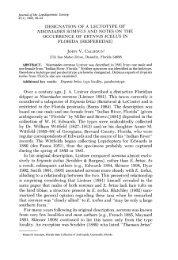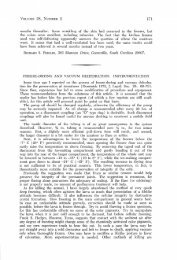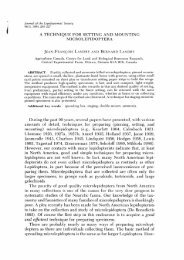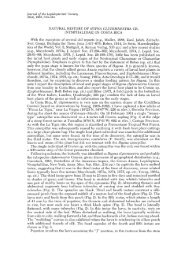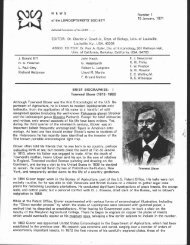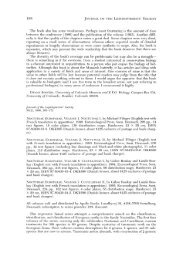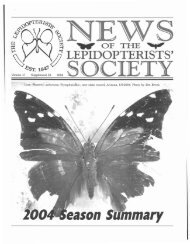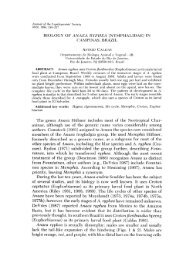HOW TO MAKE REGIONAL LISTS OF BUTTERFLIES - Yale University
HOW TO MAKE REGIONAL LISTS OF BUTTERFLIES - Yale University
HOW TO MAKE REGIONAL LISTS OF BUTTERFLIES - Yale University
Create successful ePaper yourself
Turn your PDF publications into a flip-book with our unique Google optimized e-Paper software.
VOLUME 33, NUMBER 4 219species are flying (often June and July, but not always or everywhere),and visit as many counties as time and funds permit. A fairly respectablelist of species and county records eventually will be amassed,and your attention may then gradually shift to intensified efforts atmore specific goals: a county still poorly represented; a species thatought to be present but of which you have few records or none. Thesearch for such a species is more efficient if you first familiarize yourselfwith available information about its habits, larval food, flight periods,and so on. Remember, some species fly only in particular seasons,especially the spring, so seasonal collecting should be added toyour field exploration program.Although you can think of the task as one of accumulating countyrecords, always remember that that is not the real goal but merely asimplified accounting proccdurc, useful for record-keeping and statisticaltreatment. With that in mind, it may help to discuss somepossible patterns you may observe.Every county has some upper limit to the number of species in it.In a reasonably diversified state some counties will have relativelymany species, others fewer. If the counties are more or less uniformin size and range of habitats, then the number of species in themshould be distributed in a Gaussian or normal curve, as in Fig. lB.Before you have begun to accumulate records, all counties in thestate have precisely zero species known from them: they would allbe ranged in a single bar at the extreme left of such a curve. As youacquire records the counties begin to move up the graph to the right.A single visit to a hitherto uncollected county may result in a dozenor so species records, shifting that county up one class interval to theright. With more visits the number will gradually increase. In Pennsylvania,a state I know well, a reasonably well-worked county-severalvisits in different seasons-will have records of some 20-60species. To increase the number beyond that point takes far moreeffort, generally possible only by residence or intensive local collecting.After some years of work, both on your part and on the part of earlierworkers as well as collaborators in various parts of the state, the distributionof counties according to number of species will look somethinglike Fig. lA, which shows the current state of knowledge ofPennsylvania butterflies. Note that the curve at this time is essentiallythree-humped: (a) a group of 25 counties (37% of the 67 counties inthe state) with fewer than 20 records each, representing those eithercollected in briefly or not at all; (b) a group of 28 counties (42%) withbetween 20 and 60 records each, representing those visited a numberof times and in different seasons; and (c) a group of 12 counties (18%)




